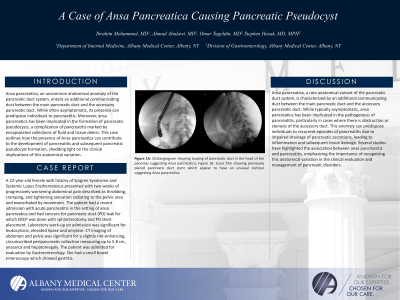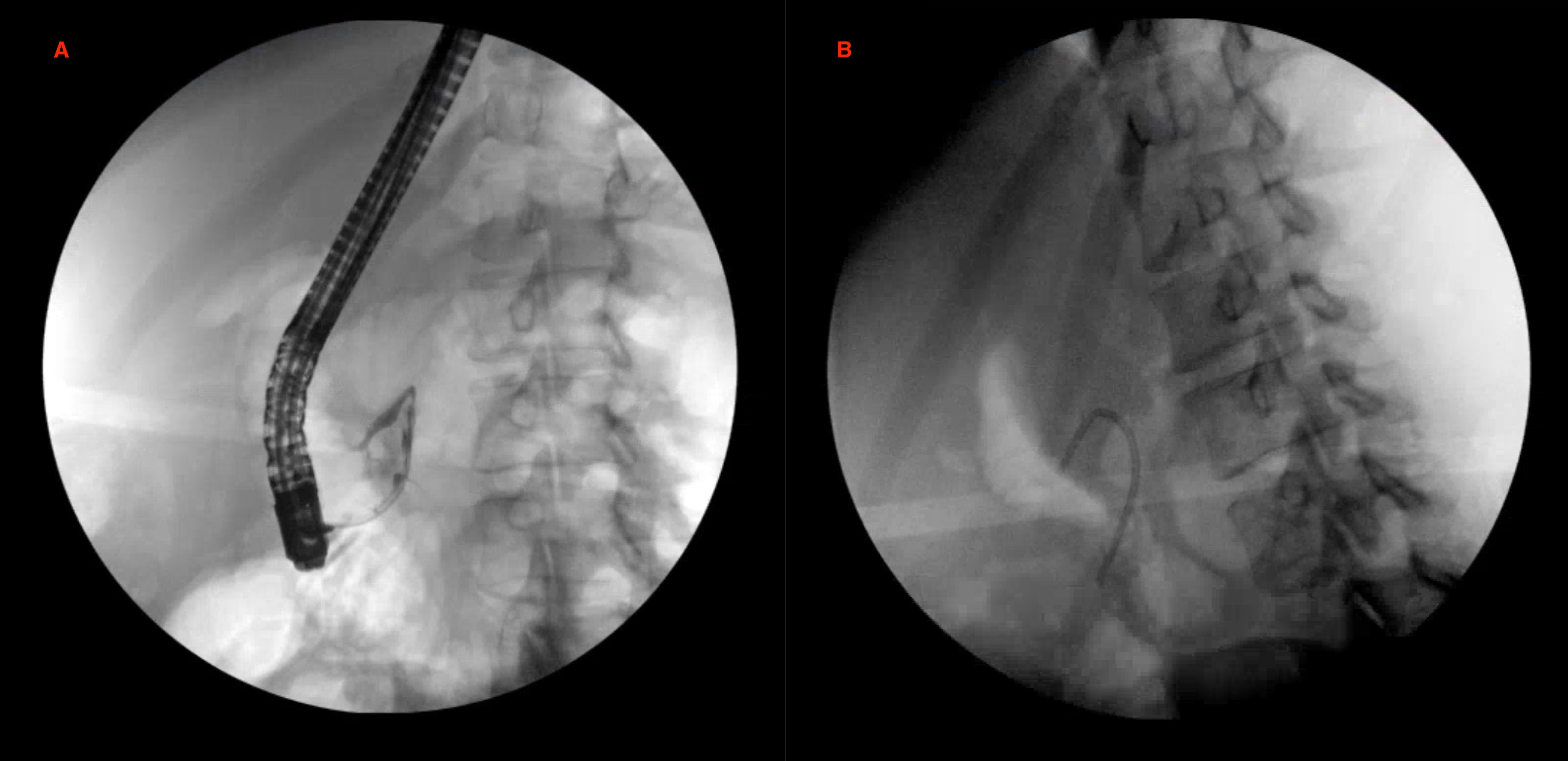Sunday Poster Session
Category: Biliary/Pancreas
P0098 - A Case of Ansa Pancreatica Causing Pancreatic Pseudocyst
Sunday, October 27, 2024
3:30 PM - 7:00 PM ET
Location: Exhibit Hall E

Has Audio
- IM
Ibrahim Mohammed, MD
Albany Medical Center
Albany, NY
Presenting Author(s)
Ibrahim Mohammed, MD1, Ahmad Abulawi, MD1, Omar Tageldin, MD1, Stephen Hasak, MD, MPH2
1Albany Medical Center, Albany, NY; 2Albany Medical College, Albany, NY
Introduction: Ansa pancreatica, an uncommon anatomical anomaly of the pancreatic duct system, entails an additional communicating duct between the main pancreatic duct and the accessory pancreatic duct. While often asymptomatic, its presence can predispose individuals to pancreatitis. Moreover, Ansa pancreatica has been implicated in the formation of pancreatic pseudocysts, a complication of pancreatitis marked by encapsulated collections of fluid and tissue debris. This case outlines how the presence of Ansa pancreatica can contribute to the development of pancreatitis and subsequent pancreatic pseudocyst formation, shedding light on the clinical implications of this anatomical variation.
Case Description/Methods: A 22-year-old female with history of Sjogren Syndrome and Systemic Lupus Erythematosus presented with two weeks of progressively worsening abdominal pain described as throbbing, cramping, and tightening sensation radiating to the pelvic area and exacerbated by movement. The patient had a recent admission with acute pancreatitis in the setting of ansa pancreatica and had concern for pancreatic duct (PD) leak for which ERCP was done with sphincterotomy and PD stent placement. Laboratory work-up on admission was significant for leukocytosis, elevated lipase and amylase. CT imaging of abdomen and pelvis was significant for a slightly rim-enhancing, circumscribed peripancreatic collection measuring up to 5.8 cm, anasarca and hepatomegaly. The patient was admitted for evaluation by Gastroenterology. She had a small bowel enteroscopy which showed gastritis.
Discussion: Ansa pancreatica, a rare anatomical variant of the pancreatic duct system, is characterized by an additional communicating duct between the main pancreatic duct and the accessory pancreatic duct. While typically asymptomatic, ansa pancreatica has been implicated in the pathogenesis of pancreatitis, particularly in cases where there is obstruction or stenosis of the accessory duct. This anomaly can predispose individuals to recurrent episodes of pancreatitis due to impaired drainage of pancreatic secretions, leading to inflammation and subsequent tissue damage. Several studies have highlighted the association between ansa pancreatica and pancreatitis, emphasizing the importance of recognizing this anatomical variation in the clinical evaluation and management of pancreatic disorders.

Disclosures:
Ibrahim Mohammed, MD1, Ahmad Abulawi, MD1, Omar Tageldin, MD1, Stephen Hasak, MD, MPH2. P0098 - A Case of Ansa Pancreatica Causing Pancreatic Pseudocyst, ACG 2024 Annual Scientific Meeting Abstracts. Philadelphia, PA: American College of Gastroenterology.
1Albany Medical Center, Albany, NY; 2Albany Medical College, Albany, NY
Introduction: Ansa pancreatica, an uncommon anatomical anomaly of the pancreatic duct system, entails an additional communicating duct between the main pancreatic duct and the accessory pancreatic duct. While often asymptomatic, its presence can predispose individuals to pancreatitis. Moreover, Ansa pancreatica has been implicated in the formation of pancreatic pseudocysts, a complication of pancreatitis marked by encapsulated collections of fluid and tissue debris. This case outlines how the presence of Ansa pancreatica can contribute to the development of pancreatitis and subsequent pancreatic pseudocyst formation, shedding light on the clinical implications of this anatomical variation.
Case Description/Methods: A 22-year-old female with history of Sjogren Syndrome and Systemic Lupus Erythematosus presented with two weeks of progressively worsening abdominal pain described as throbbing, cramping, and tightening sensation radiating to the pelvic area and exacerbated by movement. The patient had a recent admission with acute pancreatitis in the setting of ansa pancreatica and had concern for pancreatic duct (PD) leak for which ERCP was done with sphincterotomy and PD stent placement. Laboratory work-up on admission was significant for leukocytosis, elevated lipase and amylase. CT imaging of abdomen and pelvis was significant for a slightly rim-enhancing, circumscribed peripancreatic collection measuring up to 5.8 cm, anasarca and hepatomegaly. The patient was admitted for evaluation by Gastroenterology. She had a small bowel enteroscopy which showed gastritis.
Discussion: Ansa pancreatica, a rare anatomical variant of the pancreatic duct system, is characterized by an additional communicating duct between the main pancreatic duct and the accessory pancreatic duct. While typically asymptomatic, ansa pancreatica has been implicated in the pathogenesis of pancreatitis, particularly in cases where there is obstruction or stenosis of the accessory duct. This anomaly can predispose individuals to recurrent episodes of pancreatitis due to impaired drainage of pancreatic secretions, leading to inflammation and subsequent tissue damage. Several studies have highlighted the association between ansa pancreatica and pancreatitis, emphasizing the importance of recognizing this anatomical variation in the clinical evaluation and management of pancreatic disorders.

Figure: Figure 1A. Cholangiogram showing looping of pancreatic duct in the head of the pancreas suggesting ANSA pancreatica; Figure 1B. Scout film showing previously placed pancreatic duct stent which appear to have an unusual contour suggesting ANSA pancreatica.
Disclosures:
Ibrahim Mohammed indicated no relevant financial relationships.
Ahmad Abulawi indicated no relevant financial relationships.
Omar Tageldin indicated no relevant financial relationships.
Stephen Hasak indicated no relevant financial relationships.
Ibrahim Mohammed, MD1, Ahmad Abulawi, MD1, Omar Tageldin, MD1, Stephen Hasak, MD, MPH2. P0098 - A Case of Ansa Pancreatica Causing Pancreatic Pseudocyst, ACG 2024 Annual Scientific Meeting Abstracts. Philadelphia, PA: American College of Gastroenterology.
